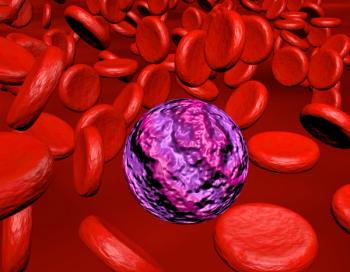
- ONCOLOGY Vol 16 No 3
- Volume 16
- Issue 3
bcl-2 Antisense as Monotherapy for Refractory Chronic Lymphocytic Leukemia
Wild-type bcl-2 protein is normally found within the bilaminar membrane of the mitochondrion, where it is believed to negatively regulate the release of cytochrome C into the cytoplasm after an apoptotic signal has triggered dimerization of bax protein.
Wild-type bcl-2 protein is normally found within the bilaminar membrane ofthe mitochondrion, where it is believed to negatively regulate the release ofcytochrome C into the cytoplasm after an apoptotic signal has triggereddimerization of bax protein. Thus, high levels of bcl-2 decrease apoptosis bypreventing or slowing downstream activation of caspases via cytochrome C.Preclinical studies have shown that antisense-mediated reduction of bcl-2consistently amplifies the cytotoxic activity of many chemotherapeutic agentsacross a broad range of hematologic malignancies and solid tumors. However,homologous recombination has generated a murine bcl-2 -/- knockout that displaysprofound immunodeficiency due to lymphoid hypoplasia, suggesting that thepresence of bcl-2 itself is an essential viability factor for lymphoid cells.
bcl-2 is commonly overexpressed in chronic lymphocytic leukemia (CLL) cells,and recent in vitro data indicate that antisense-mediated reduction of bcl-2protein directly induces apoptosis of CLL cells in the absence of other agents.Therefore, concurrent with a randomized trial that uses bcl-2 antisense (Genasense)combined with fludarabine (Fludara)/cyclophosphamide (Cytoxan, Neosar), weinitiated a clinical study to evaluate its pharmacokinetics in CLL patients,biokinetics of bcl-2 protein down-regulation, and reexpression in CLL cells, andto examine whether this drug exhibited single-agent activity independent of itschemosensitizing effects.
To date, 14 patients have been treated with bcl-2 antisense administered as acontinuous IV infusion at doses ranging from 3 to 7 mg/kg/d for 5 to 7 daysevery 3 weeks. At the 5- and 7-mg/kg/d dose levels, 6 patients experienced highfever; 6 patients had hypotension (2 severe) and hypoglycemia requiringintensive care unit admission. One patient developed transient acral cyanosisdue to development of a cold agglutinin during the first course, and one patientdeveloped severe sacral pain and a Coombs-positive hemolytic anemia during thesecond course. Several patients achieved reduction of peripheral leukocytosis,one of whom had tumor lysis syndrome.
CONCLUSION: In summary, unlike patients with solid tumors who routinelytolerate doses of 7 mg/kg/d (but similar to patients with non-Hodgkin’slymphoma), patients with CLL appear markedly more sensitive to bcl-2 antisense.Whether this decreased tolerance is due to the differing biology of bcl-2 inlymphoid cells is unclear. Because of these reactions, all current studies inCLL have reduced initial drug dose to 3 mg/kg/d, used prednisone (10 mg/d × 3 days) to ameliorate early febrile response, and employed appropriateprophylaxis against tumor lysis. bcl-2 antisense may exert single-agent activityin CLL that does not depend upon chemosensitization to other cytotoxic drugs.
Articles in this issue
almost 24 years ago
Single-Agent Rituximab in Early-Stage Chronic Lymphocytic Leukemiaalmost 24 years ago
Recruitment for Trial of Adjuvant Trastuzumab Under Wayalmost 24 years ago
Rituximab in the Treatment of Acquired Factor VIII Inhibitorsalmost 24 years ago
Support for New Medicare Pay Formulaalmost 24 years ago
Irinotecan-Containing Regimen Improves Survival in Small-Cell Lung CancerNewsletter
Stay up to date on recent advances in the multidisciplinary approach to cancer.


















































































